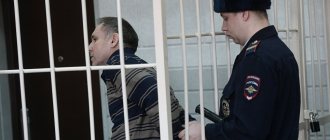Any unfinished crime constitutes an attempt. Tried to steal and was detained - attempted theft, tried to cause grievous harm and was stopped - attempted bodily harm, tried to kill and failed - the actions of the culprit involve attempted murder of a person. In the latter case, in practice problems arise with the correct determination of qualifications. It is often difficult to determine what the criminal wanted - simply to make threats and back them up with appropriate actions, or to actually kill. There are many signs by which you can accurately determine the intentions of the guilty person - we will talk about them in this article.
Punishment period for attempted murder, Article 30, 105 of the Criminal Code of the Russian Federation
A former Afghan, awarded orders for bravery, who had a minor conviction for causing grievous bodily harm in a fight, decided to take revenge on the head doctor of the village hospital because, in his opinion, she was guilty of the death of his brother, who was lying in this hospital, since she did not give him a drug. As a result, the patient escaped from the hospital and on the way to another city, where he hoped to receive a dose, on the train he began to experience withdrawal symptoms and his heart could not stand it. He died. The Afghan brother lay in wait for the doctor in the forest plantation and prepared to shoot him with a Saiga carbine. However, the detective and his brother stopped this attempt. Can an Afghan get a suspended sentence or an acquittal due to lack of evidence? Taking into account military merits. There were no other witnesses.
Gravity of the crime and statute of limitations
Responsibility under Art. 30 of the Criminal Code of the Russian Federation occurs for a citizen even when he is only planning to commit a crime : he is developing a plan, acquiring or preparing a murder weapon. The severity of an imperfect or partially committed offense is qualified in accordance with Art. 105. If the plan was to attempt to murder at least two persons, with particular cruelty, or to deliberately cause death for hire, then the sentence for such a crime will be substantial (up to 20 years).
With what intent is an attempted murder possible? Exclusively with the direct one, since the criminal was aware that his actions were criminally punishable and potentially dangerous for the person whom he wished death. Yes, the court takes into account mitigating circumstances, for example, a state of passion, the occurrence of which must be proven.
Based on Part 3 of Art. 30 of the Criminal Code of the Russian Federation, attempted crime is an action that was not completed by the attacker due to the occurrence of certain circumstances. Attempted murder can also be considered the infliction of grievous bodily harm, although the accused of such a crime will in every possible way assure the court that he “just wanted to beat the victim” and had no intention of killing him. In practice, it turns out that Article 105 is very difficult to distinguish from Art. 111 (intentional infliction of grievous bodily harm).
Application of Art. 105 via Art. 30. Part 3 of the Criminal Code of the Russian Federation must be justified, and here much depends on the competence of the judge. Representatives of the prosecutor's office themselves realize how difficult it can be to qualify such acts. Therefore, the presence/absence of intent and the circumstances that led to the termination of the crime are always taken into account (what obstacles prevented the criminal from completing his plan).
Trial
This is interesting! Criminal Code - Article 119 of the Criminal Code of the Russian Federation: threat to human life and health
The presence of deliberate intent, a clear awareness of the onset of negative consequences and the desire for death to a person - all this together allows the competent authorities to initiate a criminal case. How much do they get for attempted murder? In different ways, depending on which part of the Criminal Code is applicable to each specific case.
If the criminal managed to avoid punishment, this does not mean that time is on his side, because an attempt on a person’s life is punishable on the basis of Art. 105 via Art. 30 of the Criminal Code of the Russian Federation, even if 10 or more years have passed since the crime was committed. According to current legislation, the statute of limitations for such crimes is 15 years .
Arbitrage practice
Example No. 1
Citizen E.G. committed illegal actions to prepare and carry out an attempt on the life of citizens E.P. and O.A.
As a result of the assassination attempt, the victims received mild to moderate physical injuries. Citizen E.G. carried out a planned attack using pre-prepared bladed weapons.
Bring the unlawful act to completion E.G. could not due to the intervention of the neighbors of the victims.
The court decided to appoint E.G. punishment for an attempt on the life of two or more persons (clause a part 2 of article 105 of the Criminal Code) in the form of imprisonment for a term of 10 years, to be served in a maximum security colony.
Example No. 2
Citizen A.V. made an attempt to murder her common-law husband G.N., while in a state of passion, which is confirmed by the conclusion of a forensic psychiatric examination.
The reason for the onset of affect in A.V. was the use of physical violence by G.N., who was intoxicated.
The accused used a kitchen knife as a crime weapon, with which she managed to stab G.N. several stab wounds.
The defendant's actions were interrupted by her relative. The court decided to appoint A.V. Punishment for attempted murder in a state of passion (Part 1. 107 of the Criminal Code) in the form of imprisonment for 1 year.
Thus, attempted murder is a criminal offense and implies liability for the perpetrator.
In judicial practice, there are certain difficulties in qualifying this type of offense due to the similarity of its composition with other types of criminal offenses.
Sentence for attempted murder of husband - judicial practice:
https://youtube.com/watch?v=Crr3LkBsPNk%3Fecver%3D1
Didn't find the answer to your question? Find out how to solve exactly your problem - call right now:
| Share with friends: |
Did you like the article? Follow site updates or.
Comments:
Types of unfinished murder
Responsibility applies not only in “ordinary” attempts to lead to death, but also in a number of exceptional cases:
- If it was planned to carry out qualified murder with aggravating circumstances.
- If a mother tries to take the life of her newborn child, but for some reason she fails to complete her plan.
- If the death was caused in a state of passion (strong emotional disturbance of a person, which arose suddenly due to the commission of illegal actions by the victim).
You are viewing the Murder section
- At least two people (or more) become victims of murder.
- Criminals kill a person who fulfills his official duties and observes his public duty. Relatives of such a person can become victims.
- Murder + kidnapping. Here - causing the death of a young child or simply a clearly helpless person (disabled, elderly, sick).
- The victim is a pregnant woman, and the criminals know this.
- Particular cruelty of the crime (burning alive, slow drowning, with torture).
- The chosen method of murder is generally dangerous. It’s one thing to shoot a person in a dark alley, another thing to start a shootout in a shopping center, where there are many possible random victims.
- The motive is blood feud. The qualification of such cases involves a lot of nuances. For example, the killer must be related to a nation that practices such revenge.
- Murder is committed by a group of any degree of organization.
- The victim dies as a result of robbery, robbery, or bandit attack. As an option - hired murder, as well as obvious self-interest.
- Criminals are driven by hooligan motives. This may include the desire to distinguish oneself, to oppose oneself to the victim and the law.
- Rape + murder. The desire to hide some crime.
- There is a hostile attitude towards a person of a certain nationality, political beliefs, belonging to a hated religious denomination.
- Murder + use of internal organs/tissues.
Impossibility of carrying out an assassination attempt
Oddly enough, but in the legislation there are types of criminal activity where attempted murder, in principle, cannot exist. Due to the impossibility of the act, the citizen cannot be judged under the relevant article. What is it about:
- If the crime is not intentional, it cannot be considered as an attempt. For example, death caused by negligence. Therefore, the case will be examined under Article 109 of the Criminal Code of the Russian Federation;
- when the limits of necessary defense have been exceeded. In this case, naturally, the case cannot be considered as an attempted murder, although excessive, the force used that led to death was used in response to aggressive and illegal actions on the part of the deceased;
- attempted murder of a law enforcement officer, and so on.
Assault on life
Also in this article we would like to consider the issue of such a concept as an attempt on life, while under the law it is customary to consider an attempt to be an unfinished type of crime. Regarding encroachment, there are several articles in the Criminal Code of Russia, namely 227, 317, 295. These are more complicated articles, as they relate to an attempt on the life of persons during execution. We are talking about public servants such as prosecutors, judges, bailiffs, and so on. That is, the crime committed against them is directly related to the activities of the above persons. For an attack on the life of such individuals, the offender will bear the strictest responsibility.
Death threat
It is not uncommon for Article 119 of the Criminal Code of the Russian Federation to appear in the investigation of such cases. It is considered when the intentions of the accused cannot be proven. For example, a person threatened that he would kill another, but at the same time his words were not supported by anything, and no attempts were made to commit murder. The task of investigators is to determine whether this was a real threat to a person’s life, or simply unsubstantiated words. To do this, evidence that can indicate the real intent of the crime is taken into account.
Serious bodily harm
Unfortunately, it is not so easy sometimes to determine the type of crime. For example, the case may not involve attempted murder, despite the fact that grievous bodily harm was inflicted, or it may be exactly the opposite. To come to a common opinion, investigators need to collect as much of the case materials as possible and thoroughly analyze all the collected evidence.
There is an underlying factor that determines whether there has been an attempted murder. We are talking about the ability of the accused to bring the case to the end. The case will be considered under Part 3 of Article 30 and Part 1 of Article 105 of the Criminal Code if there is evidence that the suspect actually tried to kill his victim, but was stopped by third parties. The case will be considered under Article 111 of the Criminal Code of the Russian Federation in the event that the suspect had the opportunity to complete his act, which led to death, but still changed his mind and did not do it.
Difference between death threat and attempt
When one person says to another the phrase: “I will kill you,” this does not mean at all that he has the desire to destroy him physically. That is, such behavior cannot be qualified as attempted murder, but punishment for such an act is provided for in the Criminal Code of the Russian Federation , and for an unfounded threat it can be imposed in accordance with Art.
119 of the Criminal Code of the Russian Federation. Intimidation and intimidation are also commonly referred to as threats to kill, although the perpetrator has no intention of causing harm or taking the life of his opponent. Every phrase thrown in the heat of a quarrel can easily lead to prison.
When the attacker carefully prepared to commit a crime and had an obsessive desire to take the life of his victim, but the murder attempt was not successful due to unforeseen circumstances, he may face imprisonment for a term of 2 to 20 years. The punishment is determined by the court, and the presence of mitigating and aggravating circumstances is taken into account.
Attempted murder can be identified by the following signs:
- The beginning of a crime. The person made the preparations and began to implement the plan. The Criminal Code of the Russian Federation, which clearly defines the options for punishment, implies that the criminal can suffer it as soon as he begins to implement his plans.
- The act was carried out, but not completely, which largely determines the elements of the crime and the punishment for it . What is the sentence for intentionally killing a person? Not at all the same as for negligent homicide.
- The attacker's actions were stopped due to circumstances beyond his control. That is, there was no murder not because the killer changed his mind, but because he was prevented from carrying it out.
Punishment for assassination attempt
What is the sentence for attempted murder? The final measure is determined by the court, which takes into account all the circumstances:
- In the absence of mitigating or aggravating circumstances, the court may decide to impose a sentence of actual imprisonment for a term of up to 15 years.
- In the presence of mitigating circumstances, the punishment is often lenient - up to 2 years in prison.
- Aggravating circumstances are grounds for imposing a more severe sentence , and if present, the convicted person can spend up to 20 years in a colony.
Aggravating circumstances
If the illegal actions of the attacker were aimed at certain categories of citizens, then this is considered aggravating circumstances, as well as illegal actions committed against two or more people , and the number of offenders does not matter (one or more). Certain categories of citizens include:
- pregnant women;
- young children;
- teenagers under the age of majority;
- military personnel;
- representatives of law enforcement agencies;
- operational services employees.
What can be the punishment for an attempt on a person's life? Any, with the exception of life imprisonment and the death penalty. The court imposes a punishment not exceeding ¾ of the term provided for in Art. 105 of the Criminal Code of the Russian Federation.
This is interesting! Criminal liability for incitement to suicide
When there can be no assassination attempt
In certain types of crimes, attempt is not classified.
The Criminal Code of the Russian Federation identifies several cases where death did not occur, but Part 3 of Article 30 will not be applied.
Such crimes include:
- In a situation where the perpetrator exceeds the limits of defense. When reacting to violent actions against oneself, a person uses force that exceeds the necessary measure of protection. For example, in nature, one friend decided to make fun of another and began to swing a knife at him. The second took this as a threat and attacked his comrade with an ax. The blow was so strong that the victim was saved with great difficulty. As a result, the culprit was convicted under Part 3 of Art. 30, part 1 art. 105 of the Criminal Code of the Russian Federation. The perpetrator tried to prove that he acted in self-defense. But the court found that the victim’s actions could not be regarded as a threat to life.
- Causing death by negligence - in this case, the mandatory principle of an intentional act disappears. Reckless injury indicates that the person did not have malicious intent. And an attempt can only be made intentionally.
- An attempt to take the life of a police officer is always qualified as an assassination attempt.
Liability of a minor
According to Art. 20 of the Criminal Code of the Russian Federation, to liability for any type of murder provided for in Art. who has reached the age of 14 at the time of committing criminal acts can be charged Consequently, the guilty person in this case will be fully liable within the limits established by Art. 66 of the Criminal Code of the Russian Federation.
However, this applies only to Art. 105. In cases where we are talking about elements of a crime provided for in certain articles (Articles 277, 295, 317 of the Criminal Code of the Russian Federation), a minor aged 14 to 16 years cannot be held accountable for them. Here only Art. 105, if the teenager’s actions show signs of its composition.
More information about the punishment of minors for causing death can be found here.
What is the penalty for attempted murder?
two or more persons; a person or his relatives in connection with the performance of official activities by this person or the performance of a public duty; a minor or other person known to the guilty person to be in a helpless state, as well as associated with the kidnapping of a person; a woman known to the guilty person to be in a state pregnancy; murder committed with particular cruelty; committed in a generally dangerous way; motivated by blood feud; committed by a group of persons, a group of persons by prior conspiracy or an organized group; for mercenary motives or for hire, as well as associated with robbery, extortion or banditry; from hooliganism motives; in order to conceal another crime or facilitate its commission, as well as those involving rape or violent acts of a sexual nature; for reasons of political, ideological, racial, national or religious hatred or enmity, or for reasons of hatred or enmity towards any social group ;for the purpose of using the organs or tissues of the victim, is punishable by imprisonment from eight to twenty years with restriction of freedom from one to two years, or life imprisonment, or the death penalty.
Responsibility under Art. 105 of the Criminal Code of the Russian Federation
The maximum penalty here will depend on the sanction provided for in the relevant part of Art.
105 of the Criminal Code of the Russian Federation. They provide:
- For the first part (ordinary murder) – from 6 to 15 years in a colony.
- For the second (qualified/serious, we will talk about them later) - from 8 to 20 years or for life.
According to Art. 66 of the Criminal Code of the Russian Federation, punishment for attempted murder cannot exceed three-quarters of the maximum term, while a life sentence is not applied. Thus, for attempted ordinary murder the perpetrator cannot receive more than 11 years 3 months, for qualified murder - 15 years.
In addition, it must be borne in mind that in some cases the attempt as such will form an additional corpus delicti. This applies to those articles where an attempt on life is considered a completed crime. These include:
- Art. 277 – Encroachment on a state or public figure in connection with his activities.
- Art. 295 – Encroachment on an investigator, judge, juror or other person who administers justice or investigation.
- Art. 317 – Encroachment on a law enforcement officer or military personnel.
In this case, the perpetrator will be held liable primarily under these articles. This is due to the fact that when there is competition between general and special norms, it is the special one that is subject to application.
Let us remind you once again that for attempted ordinary murder (Part 1 of Article 105 of the Criminal Code of the Russian Federation), the maximum penalty will not exceed 11 years and 3 months.
You can find out more about the punishment for killing a person here.
Qualifying features
In the event that not an additional article is applied, but Art. 105 in conjunction with Art. 30 of the Criminal Code of the Russian Federation, additional qualifying features listed in the relevant paragraphs of Part 2 of Art. 105. These include:
- Attempt on two or more persons (item “a”). An unfinished crime is possible against not only one person, but also several.
- An attempt on the life of the person himself or his loved ones due to official actions or the performance of public duty (clause “b”). Here you need to make sure that in the end the attempt does not turn out to correspond to the composition of one of the special articles listed above.
- For a minor or other helpless person (item “c”) or for a pregnant woman (item “d”). This type of crime is considered especially socially dangerous.
- Associated with special cruelty (item “d”) or committed in a socially dangerous way (item “f”). While these criteria typically apply to completed crimes, they will also be considered if the victims ultimately survived.
- Related to blood feud (clause “e.1”). The custom of blood feud is a dangerous relic for society, so even attempted murder in this case will be punished especially harshly.
- A group of persons with or without conspiracy, as well as an organized group (clause “g”). In cases where a whole group turns out to be criminals, the crime carries a special danger, and therefore even an attempt on it will be punished especially harshly.
- Associated with selfish motives, hiring, as well as robbery, banditry, etc. (item “h”).
- Associated with hooligan motives - that is, with a rude challenge to others and a demonstrative violation of public order (item “and”).
- Committed to hide another crime (in particular, rape) (item “k”).
- Associated with political, social, racial or other hatred (clause “l”).
- Committed for the use of the victim’s organs (clause “m”).
Important! Regardless of the qualifying feature, the maximum penalty is no more than 15 years (Part 3 of Article 66 of the Criminal Code of the Russian Federation).
High-profile cases
High-profile attempted murder cases include:
- On heads of state, which is tantamount to an attack on the state itself and its structure.
- Religious leaders of states.
- Presidential candidates.
Here are just a few examples.
Assassination attempt on Joseph Stalin. On November 6, 1942, S. Dmitriev, who hid on the Execution Ground of Red Square and left his military unit without permission, fired shots at Stalin’s car, which was driving from the Spassky Gate. The criminal was disarmed by the guards, there were no casualties. Historians believe that the criminal confused Stalin's car with Mikoyan's car.
Attack on Vladimir Lenin. The most famous attack occurred on August 30, 1918 in Moscow. On this day, Lenin spoke at the plant named after. Mikhelson in Moscow. At the end, he was supposed to get into the car, but at that moment 3 shots were fired. Lenin was seriously wounded. The police immediately detained Socialist-Revolutionary Fani Kaplan, who admitted her guilt.
Attack on Adolf Hitler. On July 20, 1944, perhaps the most daring attempt to assassinate the Fuhrer was carried out. On that day, the future of war was influenced by an ordinary cabinet.
By the summer of 1944, Germany began to lose. But as long as the Fuhrer was in power, capitulation was impossible. These circumstances led some military personnel to the idea of overthrowing the Nazi regime. The first attempt was made on July 11 at a conference in Berchtesgaden. But the Fuhrer did not show up, which is why the mission was postponed. And already on July 20, Stauffenberg headed to the Fuhrer’s headquarters “Wolf’s Lair”. The colonel had 2 suitcases: with papers and with an explosive mechanism. At the meeting, the colonel asked to be seated next to Hitler, explaining that he had poor hearing, and placed explosives a few meters from Hitler. Under the pretext of talking on the phone, the colonel left the premises and activated the bomb. But the Valkyrie mission, which had the goal of seizing power and forming a provisional government, did not come true. After Stauffenberg left, Colonel Franz Brandt sat closer to the Fuhrer and moved the briefcase to another place on the cabinet. The explosion killed four people. However, Hitler was not injured. On the same day, Olbricht and Stauffenberg were shot.
Encroachment on Alexander II. In the fall of 1879, members of Narodnaya Volya planned to blow up the train on which Alexander II arrived from Crimea. But at the last minute the train changed its route. On November 18, when the train approached the terrorist, a Narodnaya Volya member tried to activate the bomb, but the explosion did not occur because the electrical circuit was faulty. Soon, Narodnaya Volya formed a third group to plant a bomb on a railroad track near Moscow. The plan failed due to unforeseen factors. In Kharkov, due to a breakdown of the baggage train, the Tsar's train was dispatched first. As a result, the criminals were only able to blow up a freight train.
Attack on Reagan. The assassination attempt took place on March 30, 1981. The President and three people from his escort group were wounded while leaving the Hilton Hotel, where Reagan was making a speech to trade unionists. The assassin was John Hinckley. At about 2:27 p.m., when Reagan left the hotel and headed to the car, Hinckley emerged from the crowd and fired 6 shots from a pistol in 3 seconds. The last bullet bounced off the body of the car, hit the president's chest, touched a rib and penetrated the lung. Hinckley was not convicted because of his insanity, but was committed to St. Helena Mental Hospital in Washington. On September 10, 2016, he was released from the medical facility and went to his mother’s house. His release is subject to certain conditions.
An attack on Putin. On March 2, 2008, a point was set up in a room on Sadovnicheskaya Street from where the shooter was supposed to fire a shot. The plan was to kill Putin and Medvedev as they moved along Vasilyevsky Spusk. A couple of hours before the opening of the official event, FSB officers entered the premises where the shooter Shakhvelad Osmanov was detained. The shooter was only charged with unlawful possession of a firearm.
The reasons and factors due to which a criminal act is not carried out to completion can be very different. But they always do not depend on the subject carrying out the attack and have no connection with the will and desire of the criminal. These may be unsuitable means of carrying out the criminal plan, impassable obstacles, unwanted witnesses, strong resistance of the victim of the attack, or the absence of the target of the attack.
When there can be no assassination attempt
The victim does not always react calmly to actions directed at her and may use force in response. If this happens, and the strength of the victim exceeds the strength of the offender, then it is incorrect to talk about an attempt. In this case, the act on the part of the victim is considered as an excess of necessary defense, as a result of which the victim herself may end up in the dock.
Another case is causing the death of the victim. If the criminal, in the course of implementing his plan, accidentally killed the victim, then another article will be charged, and the punishment will be appropriate. The investigator will need to reclassify the act.
If a criminal during an attempt killed a law enforcement officer, then Article 105 of the Criminal Code of the Russian Federation does not apply to him; his act is qualified according to another norm. In this case, we can talk about the absence of an attempt and the presence of another crime.
In the listed cases, it is incorrect to talk about the imputation of the article on the attempt, from a legal and legal point of view.
Subjective signs
The subject of any crime is a sane person, and an individual who has reached the age of criminal responsibility. In the case of murder, the lower age limit is set by law at fourteen years, which occurs due to the fact that intentionally causing death, as well as attempting to do so, is a particularly serious crime.
The subjective side is the mental attitude of a person to an act, manifested in one form or another of guilt. An attempt is always made intentionally, and this is necessarily direct intent. The person directs his actions and desires the occurrence of negative consequences. The Criminal Code in Article 105 gives a clear concept of murder, which does not allow for any other subjective side of this crime.
ATTEMPTED CRIME
In contrast to the preparation of an assassination attempt, the subject has already encroached on the object, has begun to carry out the objective side of the criminal act, actions during an assassination attempt indicate, firstly, that there is a real danger of causing harm to the object of the assault and, secondly, the determination of the person, who chose to move on to the next stage of development of criminal activity, thus revealing his “evil will.” At the same time, in a number of cases, the same actions may indicate both an attempted crime and preparation for it. It all depends on the act towards which the intention of the perpetrator is directed, for example, entering someone else’s apartment with the purpose of committing murder is assessed as preparatory actions, and the same act with the aim of stealing is assessed as an attempt.
What types are there?
Attempts in the theory of criminal law are usually divided into several different types:
- Finished. In this case, the perpetrator performed all the actions necessary to cause death. However, the result did not occur due to reasons beyond the control of the person. An example of this can be considered the following situation: the criminal took out a pistol, took aim correctly, pulled the trigger - but at the last moment his hand trembled or the intended victim suddenly abruptly moved from the line of fire. Here the would-be killer did everything that depended on him, but the crime could not end.
- Unfinished. Here the criminal does not complete the murder process - however, also not through his own fault. Relatively speaking, the killer took aim - but a random passer-by knocked the pistol out of his hands. Here it cannot be said that everything was done to obtain a result, however, as in the previous case, the criminal was unable to kill due to circumstances that were beyond his control.
- With worthless means. In this case, the criminal performed all the necessary actions, not knowing that the weapon he was using was not suitable for murder. Returning to the example with the pistol: the criminal took aim, pulled the trigger, no one stopped him - but it turned out that the pistol’s firing pin had long been sawed off, and the would-be killer did not know about it.
- To an unusable object. In this case, the offender does not know that his actions cannot harm the victim. If we continue to use the example with a pistol, then in this case the criminal shoots, not knowing that the bullet will hit the doll representing the victim - or the corpse, if the victim was already dead by that time. In practice, this type is extremely rare.
More details about the types of murders and other nuances of the crime can be found here.
Arbitrage practice
If we talk about judicial practice in cases of murder under Article 105 of the Criminal Code of the Russian Federation, it is worth noting that before establishing responsibility for a crime, the court takes into account many factors:
- qualifications (qualified murder or unqualified misdemeanor);
- lawyer's speech;
- connections with criminal groups;
- video evidence;
- mock crime.
The court considers the case for at least a month (this time is necessary to familiarize yourself with the case materials, determine the punishment, and consider the problem individually). The legislation (its norm) does not limit the period of consideration (there may be several appeals, rescheduling of hearings, etc.) - this can last a year or more.
The lawyer representing the interests must have an appropriate diploma. Court decisions are often made in favor of the victim - the perpetrator then ends up in punishment. There he may be subject to an amnesty after some time. He can also ask for parole. The basis for this will be a positive characteristic from the colony.
The jurisdiction of such cases most often is at the place of residence of one of the subjects or the place where the crime was committed. For example, a crime against citizen Lebedev was committed in Zelenograd by a group of people from Lipetsk. The case may be considered at the place where it was committed.
What is it Definitions of concepts
In most cases, the punishment provided for by the Criminal Code of the Russian Federation is imposed for a crime that has already been completed. However, situations are possible when criminal actions for some reason were not brought to the result planned by the criminal. It is then that we can talk about an attempt or an unfinished murder.
Russian criminal legislation divides crimes into completed and unfinished (Article 29 of the Criminal Code of the Russian Federation). The difference between them is as follows:
- An act that contains all the elements of a crime provided for by the relevant norm of the Criminal Code of the Russian Federation (in relation to murder - Article 105) is considered completed.
- Preparation for a crime and an attempt on it are considered unfinished (Article 30 of the Criminal Code of the Russian Federation).
The concept of assassination attempt is described in Part 3 of Art. 30 of the Criminal Code of the Russian Federation. According to its norms, this concept means the following:
- The actions (or inaction, since in certain cases one can kill by inaction) of the guilty person have already taken place.
- The result to which the intent of the perpetrator was directed (namely, causing the death of another person) was not achieved.
- Moreover, the result was not achieved due to circumstances that did not depend on the will of the criminal (third parties intervened, the crime weapon turned out to be unusable, etc.).
For comparison, you need to indicate what is called preparation for a crime. According to Part 1 of Art. 30 of the Criminal Code of the Russian Federation, this concept refers to actions that are not yet directly aimed at committing a crime, but are preparation for it. This may be a conspiracy between accomplices, the search for instruments of crime, as well as other deliberate actions aimed at creating conditions for a criminal act. Cooking is punishable in two cases:
- When it itself constitutes a crime (for example, when, in preparation for murder, a person illegally acquires and stores military weapons or other weapons of crime from among the things prohibited for circulation).
- When it comes to preparing to commit a serious or especially serious crime. The degree of severity is determined according to the rules of Art. 15 – and art. 105 of the Criminal Code of the Russian Federation falls into this category.
Important! When the preparation contains signs of a separate crime, the perpetrator will be convicted under two articles at once, and the punishment will be assigned to him according to the rules of addition established by Art. 69 of the Criminal Code of the Russian Federation.
. Differences between an attempt and a threat
Differences between an attempt and a threat
Partially similar to an attempt or preparation is the crime of threat of murder (Article 119 of the Criminal Code of the Russian Federation). The main difference between these two types of illegal acts is as follows:
- The purpose of the threat is psychological pressure on the victim. The purpose of an unfinished murder is to directly cause death, even if not completed for some reason.
- The threat is qualified under a separate article of the Special Part of the Criminal Code of the Russian Federation and does not require a reference to Art. 30 General Part. Attempt always requires this link, since it usually does not form an independent crime - it is punished only as part of the general crime provided for in Art. 105 of the Criminal Code of the Russian Federation.
- Attempt requires certain actions aimed at causing death to the victim. For a threat, only the very fact of the statement is enough; no additional actions from the perpetrator are required.
Problems of differentiation from other compounds
Some difficulties in determining qualifications may arise when distinguishing between premeditated attempted murder and other offenses.
Death threat
Thus, it is not uncommon for a guilty person to shout “I’ll kill” and put a knife to his throat, strangle him with his hands or with a rope, etc.
How can you tell if a criminal's intentions are real? How to evaluate his actions - as part 3 of Art. 30 hours 1 tbsp. 105 of the Criminal Code of the Russian Federation or Art. 119 of the Criminal Code of the Russian Federation (threat of murder)? In such difficult situations, it is impossible to determine the correct qualification without carefully studying all the circumstances, the smallest details and reliable data on the direction of intent. It is especially important to correctly assess what is happening, given the huge difference in punishment for committing these crimes. So, according to Art. 119 of the Criminal Code of the Russian Federation, the maximum punishment facing the perpetrator does not exceed 2 years of imprisonment.
Example No. 7 . Marchenko V.A. during a quarrel with his shift partner, he began to choke him, pressing him with his body to the floor. Victim Ermolin R.L. was weaker in build than Marchenko, 20 cm shorter than him, weighed 63 kg, while Marchenko V.A. with a height of 188 cm, he weighed 110 kg, and had been professionally engaged in wrestling all his life. These data helped the court to conclude that the actions of Marchenko V.A. there was an attempted murder, in this regard, he was given a sentence of 11 years in prison under Part 3 of Art. 30, part 1 art. 105 of the Criminal Code of the Russian Federation. The judge indicated in the verdict that Marchenko V.A. had the direct intent to deprive the victim of his life, since his actions of strangulation were directly aimed at achieving this goal. Marchenko stopped only after the active intervention of the head of security, who forcibly pulled the culprit away from the victim, while Ermolin R.L. lost consciousness, serious consequences were recorded in the form of significant damage to the trachea, which resulted in disability. The convict's arguments that he wanted to show only a threat in this way and committed a crime under Art. 119 of the Criminal Code of the Russian Federation were considered unconvincing.
Thus, when distinguishing between these crimes, law enforcement agencies proceed from the totality of evidence indicating the presence of intent to kill, or the absence of this criterion;
Serious bodily harm
Criminal cases where the victim has suffered grievous bodily harm are the most difficult from the point of view of a correct legal assessment.
Example No. 8 . Kolosov A.K. struck P.L. Mlechnikov twice with a screwdriver in the heart. during a fight. The victim miraculously survived, underwent multiple surgeries to restore connective tissue, and was in hospital for a long time. The harm caused to Mlechnikov P.L. was recognized by the expert as serious, life-threatening, which means a very real lethal outcome in the absence of medical intervention. Kolosova A.K. accused under Part 3 of Art. 30, part 1 art. 105 of the Criminal Code of the Russian Federation. However, his lawyer did not agree with this article, believing that the case should be initiated under Part 2 of Art. 111 of the Criminal Code of the Russian Federation and punishment must be determined only for causing grievous harm to health, the intent to take life has not been proven.
In the appeal court, the verdict under Part 3 of Art. 30, part 1 art. 105 of the Criminal Code of the Russian Federation remained in force, since the actions of A.K. Kolosov, taking into account targeted attacks using a pre-prepared weapon in one of the most important human organs, were regarded as confirmation of the desire to kill.
Example No. 9 . Artamonov A.I. caused serious bodily injury to Nosov K.R. in the form of a ruptured spleen, the case was investigated and tried in court under Art. 111 of the Criminal Code of the Russian Federation - intentional infliction of grievous bodily harm dangerous to life. Artamonov A.I. entered into with Nosov K.R. into a fight, which resulted in no less than 7 kicks to the body of Nosov, who remained alive thanks to a timely operation. It was not possible to prove that Artamonov foresaw and desired the death of the victim. Thus, from the expert’s interrogation it followed that in such conditions, if the same blows were inflicted on another person, there might not have been consequences in the form of a ruptured spleen. The culprit could not know for sure that Nosov could die from kicks. The sentence was passed under Art. 111 of the Criminal Code of the Russian Federation.
The ability to complete your actions
Another point that is always taken into account when delimiting crimes is finding out the possibility of completing one’s actions. So, if the culprit continues his actions of striking, strangling, etc., but he is stopped by other persons, the active resistance of the victim, etc., the qualification under Part 3 of Art. 30, part 1 art. 105 of the Criminal Code of the Russian Federation.
If the perpetrator had the opportunity to complete his crime and cause death, but he did not do this, then his actions would be correctly qualified under Art. 111 of the Criminal Code of the Russian Federation.
Attempted murder article
Judicial practice for investigating cases under Article 105 of the Criminal Code provides for a standard process. Initially, a specific number of victims is established (in some cases the murder of two or even more persons was envisaged). It is worth noting that in legal practice some kind of distinctions are immediately found. It is difficult to understand and analyze in this context, because a person can die as a result of an injury and does not do this immediately after the fact of injury has been established. In practice, they try to be attentive to the search for an object and a subject, to consider both of these sides, to establish whether a crime for hire was committed, and to use appropriate models. Cases involving minor children (minors) are also closely examined. Based on the data obtained, a disposition is subsequently formed and a hypothesis is developed.
Attempted murder is possible
Given in Part 1 of Art. 30 of the Criminal Code of the Russian Federation, the legislative definition of the concept of preparation is specific from the point of view of its legislative technique. It begins with the definition of particular cases (with specification) of preparatory actions in the form of finding, manufacturing or adapting means or instruments for committing a crime, finding accomplices of a crime, conspiracy to commit it, and ends with a general formula - the concept of deliberately creating conditions for the commission of a crime. In this regard, any preparatory actions are always the deliberate creation of conditions for the commission of a crime, including specific types of preparation.
The lawyer managed to reclassify the case from attempted murder to minor bodily harm.
As AG learned, on December 13, 2022, a magistrate in Moscow dismissed the criminal case against a citizen of Uzbekistan who stabbed his partner several times.
Investigation version
From the decision to charge him as a defendant (available to the “AG”) it followed that in August 2022, citizen of Uzbekistan N. stabbed his partner twice with a knife against the backdrop of a sudden personal hostility. The incident occurred on a playground near a residential building in Moscow. According to investigators, the knife was stabbed in the area of vital organs - in the chest and neck of the victim.
A criminal case against N. was initiated on August 23, he was placed in custody in one of the Moscow pre-trial detention centers. Subsequently, the interdistrict investigative department of the Main Investigative Directorate of the Investigative Committee of the Russian Federation in Moscow charged him with attempted murder under Part 3 of Art. 30, part 1 art. 105 of the Criminal Code of the Russian Federation. According to law enforcement officers, the guilt of the accused was proven by his testimony, the conclusion of a forensic expert and witness testimony.
The lawyer who intervened in the case petitioned to dismiss the case
Stepan Dilbaryan entered the criminal trial at the invitation of N.'s relatives on October 7. On October 29, the defense attorney petitioned (the document is available from “AG”) to dismiss the criminal case, pointing out that the accusation was clearly unfounded.
The lawyer referred to the fact that the forensic expert’s report indicated that the bodily injuries inflicted on the victim were not life-threatening and did not cause the development of a life-threatening condition. “So, from the case materials it follows that after cutting the victim, N. did not take any further action, although nothing prevented him from doing so. The eyewitnesses were at a considerable distance at the time of the incriminated events and for some time immediately after the cutting. And the wording left in the accusation that the victim’s death did not occur due to the timely provision of medical care to her is in direct contradiction with the conclusion of the forensic medical examination,” the petition noted.
Stepan Dilbaryan added that even if we agree with the conclusion of the investigation that N. had an intent to kill, then the subsequent circumstances should be regarded as a voluntary renunciation of the crime (Article 31 of the Criminal Code of the Russian Federation), since he did not have the ability to complete such an intent no obstacles, the presence of which is mandatory by virtue of Part 3 of Art. 30 of the Criminal Code of the Russian Federation. The defense attorney added that his client intended to stab her with a knife not in the victim’s neck, but in the shoulder. In addition, he believed that N. had incriminated himself when giving evidence.
Nevertheless, the investigation refused to satisfy the lawyer’s request. In the resolution (available from the “AG”) on the complete refusal to satisfy the petition, it is noted that the defense lawyer’s arguments are refuted by data from surveillance cameras, as well as by the testimony of the accused himself. The investigation also did not reveal the fact of a slander on the part of the accused, who was interrogated in the presence of a defense attorney as assigned and without putting pressure on him.
The prosecutor's office returned the case to the investigator
On November 8, the interdistrict prosecutor's office issued a decision to return the criminal case to re-draft the indictment. In this document (available to the “AG”) it was noted that the indictment could not be approved due to incorrect personal data of the person brought in as an accused. In addition, in violation of Part 2 of Art. 220 of the Code of Criminal Procedure of the Russian Federation, the indictment incorrectly cited references to the testimony of one of the witnesses, as well as sheets containing a blueprint of the accused’s passport.
“The violations committed in the preparation of the indictment exclude the possibility of the court passing a verdict or making another decision based on this conclusion. Thus, the criminal case must be returned to re-draft the indictment and eliminate the identified deficiencies,” the prosecutor’s office indicated.
Reclassification of crime
Subsequently, in a decision dated November 22 on the partial termination of the criminal case (available to the “AG”), the senior investigator indicated that the investigation had not reliably established the presence of the defendant’s direct intent to kill the victim. After causing bodily harm to his partner, N. did not take any active steps to complete the intent to kill. To substantiate its position, the investigation referred to Resolution No. 1 of the Plenum of the Armed Forces of the Russian Federation dated January 27, 1999, according to which attempted murder is possible only with direct intent.
In the case under consideration, as the investigation explained, the victim did not offer any active resistance after the injuries were caused, and the intervention of outsiders occurred a significant period of time after the incident. The wound to the neck itself, according to the forensic expert, was not life-threatening.
In this regard, a criminal case under Part 3 of Art. 30, part 1 art. 105 of the Criminal Code of the Russian Federation in relation to N. was terminated on the grounds provided for in Part 1 of Art. 27 of the Code of Criminal Procedure of the Russian Federation, and later he was charged with clause “c” of Art. 115 of the Criminal Code of the Russian Federation (intentional infliction of minor harm to health). The case was sent to the magistrate's court for consideration on the merits.
The magistrate dismissed the criminal case due to the reconciliation of the parties
During the trial, the victim announced reconciliation with N. and petitioned for the termination of the criminal case against the latter. The defendant’s cohabitant argued that she had no claims against him, since he apologized to her and compensated for the harm caused to her.
The defendant did not object to the petition, confirmed the fact of compensation to the victim for harm and explained that he repented of his actions. His lawyer also petitioned the court to dismiss the case in connection with the reconciliation of the parties. In the corresponding petition (available from “AG”) Stepan Dilbaryan, with reference to paragraph 9 of the Resolution of the Plenum of the RF Armed Forces dated June 27, 2013 No. 19, noted that in accordance with Art. 76 of the Criminal Code of the Russian Federation, exemption from criminal liability in connection with reconciliation with the victim is possible if two conditions are met (reconciliation of the person who committed the crime with the victim and compensation for the harm caused to him).
In turn, the representative of the state prosecution objected to the satisfaction of the victim’s request.
In its decision (available from the “AG”) the magistrate’s court indicated that the crime provided for in paragraph “c” of Art. 115 of the Criminal Code of the Russian Federation, belongs to the category of minor gravity, and the defendant is brought to criminal responsibility for the first time. At the same time, he took into account the fact that the accused was not registered with a narcologist or a psychoneurological dispensary, as well as his positive characteristics at his place of residence and work. “The reconciliation of the parties and compensation for harm are evidenced by the statements made by the parties, the accused admitted his guilt and repented of his actions, apologized to the victim, who confirmed that she had reconciled with N. and forgave him, the harm caused was compensated, as indicated in the statement,” - The court noted and decided to terminate the criminal case due to the reconciliation of the parties. The accused was released from custody in the courtroom.
The defense lawyer commented on the progress of the case
In a commentary to AG, Stepan Dilbaryan, lawyer for the Manakov and Partners firm, who defended N., said that the defense in the criminal case was complicated by the fact that the investigator in the first 24 hours after N.’s arrest (i.e., before he entered the case) A protocol was drawn up for interrogating the suspect, from which it followed that he admitted both the intention to kill the victim and the infliction of two stabs with a knife in the area of the latter’s vital organs with the aim of causing her death. “In addition, the investigator drew up a protocol for checking the testimony on the spot and a number of other procedural documents. When I read the protocols signed by him to the principal, their contents and wording caused him bewilderment. He explained that he did not talk about any desire to kill, especially about striking with the aim of killing, but only acknowledged the conflict that had occurred and was sure that this was what he was accused of and that it was in this form that his testimony was included in the protocol.” “, the lawyer explained.
According to the defense lawyer, a careful study of N.’s testimony made it possible to emphasize their inconsistency. “So, in the same testimony, it was first stated that the blow was delivered to the neck area, but a little later it was stated that the blow was delivered to the face area. In the same testimony, it was indicated that the interrogated did not remember where he hit the knife, but he still claims that he hit him in the neck. In addition, according to the testimony, he took a knife out of his pocket and stabbed with it to kill, but for some reason he did not remember exactly how he held the knife and where its blade was directed. All this sounded absurd,” noted Stepan Dilbaryan.
According to the lawyer, such confused testimony of the accused is typical for cases when the person being interrogated is “helped” to compile it by those who understand exactly what formulations are needed for the “correct” qualification and what details are better not to be written before the expert’s conclusion, which otherwise may negate the received testimony (including due to incorrect indication of where the blade was directed and in terms of the direction of the blow). “And for a person who actually intentionally inflicted such a blow, as a rule, it is not difficult to describe his actions in the smallest detail. However, for the effective protection of the principal, the stated contradictions alone were completely insufficient, because there were simply no serious procedural grounds for excluding the specified evidence, and the assessment of this evidence is always a rather subjective matter,” said Stepan Dilbaryan.
In this regard, it was decided to build the defense somewhat differently. Taking into account the specifics of the legislative structure of an unfinished crime (attempt), emphasis was placed on the unproven circumstances that prevent the crime from being completed, the defense lawyer explained. To this end, detailed evidence about the circumstances of the case was examined and given. Further, after familiarization with the materials of the criminal case in accordance with Art. 217 of the Code of Criminal Procedure of the Russian Federation, the defense filed a petition to consider the criminal case by a jury.
“This line of defense was based on the position of the Supreme Court, which indicated that for this category of crimes, jurors should be asked in clear terms the questions provided for in Art. 339 of the Code of Criminal Procedure of the Russian Federation, including the proof of the reasons why the act was not completed. Moreover, this question must contain a description of the factual reason that deprived the defendant of the opportunity to carry out his intentions. At the same time, based on the results of studying the materials of the completed criminal case, a petition was prepared to terminate the criminal prosecution under Part 3 of Art. 30, part 1 art. 105 of the Criminal Code of the Russian Federation (i.e. attempted murder) with detailed motivation, the purpose of which is to indicate to the investigator, the head of the investigative body and the prosecutor that there is insufficient evidence for a jury to issue a guilty verdict under Part 1 of Art. 105 of the Criminal Code of the Russian Federation, taking into account the greater objectivity of such a court,” the lawyer said. In his opinion, focusing on this allowed the prosecutor to more carefully study the case materials and return it to the investigative body, which has already reclassified N.’s actions.
“Since by the time the case was considered in the magistrate’s court, the accused had compensated for the damage caused, the defense invited the victim to petition the court to terminate the criminal case in connection with the reconciliation of the parties, which she did. A similar motion to dismiss the case was filed by the defense,” added Stepan Dilbaryan. He expressed satisfaction with the court ruling that came into force.
You are viewing the Murder section
- Immediately or shortly after birth, the mother kills her newborn child. It is believed that in this case the woman is in a state of extreme stress and often loses the ability to fully understand and control her actions. Article 106 is considered very ambiguous by practicing criminologists and ordinary people. The need to tighten punishment for mothers in such cases has been discussed for a long time.
- Murderers often appeal to Article 107, which talks about the state of passion. If a person has become a victim of bullying or torture, he can often turn into a punisher. In such cases, one of the key factors in proving/refusing affect is the conclusion of a psychological and psychiatric examination.
- One of the less recognized articles by the courts is the excess of defensive measures. Judicial practice knows a huge number of cases when crimes are reclassified from Art. 108 at station 105. Murders specifically under Article 108 are considered one of the most difficult to prove.









